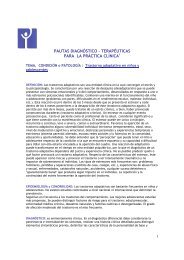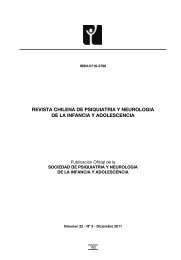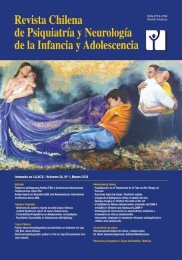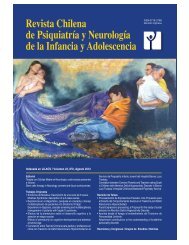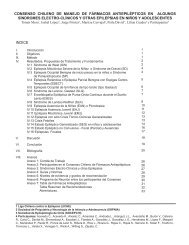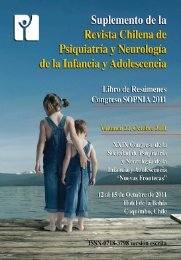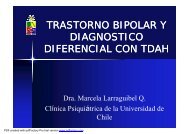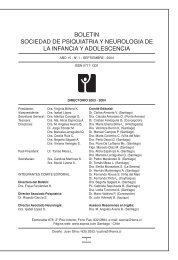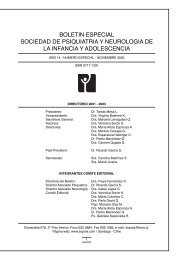revista chilena de psiquiatria y neurologia de la infancia y ...
revista chilena de psiquiatria y neurologia de la infancia y ...
revista chilena de psiquiatria y neurologia de la infancia y ...
- No tags were found...
You also want an ePaper? Increase the reach of your titles
YUMPU automatically turns print PDFs into web optimized ePapers that Google loves.
Volumen 22Nº 2Trastorno por déficit <strong>de</strong> atención/hiperactividad (TDAH). Revisiónlento sin hiperactividad-impulsividad, exten<strong>de</strong>r<strong>la</strong> edad <strong>de</strong> comienzo <strong>de</strong> los síntomas comocriterio para TDAH, crear umbrales y listas <strong>de</strong>síntomas a<strong>de</strong>cuados a <strong>la</strong>s diferentes etapas<strong>de</strong>l <strong>de</strong>sarrollo (disminuyendo los síntomas <strong>de</strong>hiperactividad, en especial en adultos), y aumentarel número <strong>de</strong> criterios para impulsividad,dada <strong>la</strong> cantidad <strong>de</strong> estudios que lo ava<strong>la</strong>ncomo característica central <strong>de</strong>l trastorno.C<strong>la</strong>ramente, el área <strong>de</strong> mayor conflicto es <strong>la</strong><strong>de</strong> <strong>la</strong> c<strong>la</strong>sificación y subtipificación <strong>de</strong>l TDAH.La pregunta es si existen realmente subtipos<strong>de</strong> TDAH o más bien fenotipos heredables queconfluyen para formar distintos fenotipos clínicos.Se <strong>de</strong>staca que el TDAH es un trastornoque posee gran heterogenicidad, que podríaexplicar que sus bases no hayan sido totalmenteac<strong>la</strong>radas a <strong>la</strong> fecha, y que se requierenmayores estudios para precisar mejor <strong>la</strong> caracterización<strong>de</strong>l TDAH en todas estas áreas.Es necesario profundizar en <strong>la</strong> heterogenicidad<strong>de</strong>l TDAH para mejorar su conceptualización,lo que estaría orientado al mejor rendimientodiagnóstico y terapéutico en el futuro.REFERENCIAS1. American Psychiatric Association (APA),Diagnostic and statistical manual of mentaldisor<strong>de</strong>rs (4 th Edition-Text Revision), 2000.2. Kessler R, Adler L, Barkley R, Bie<strong>de</strong>rman,et al. The prevalence and corre<strong>la</strong>tes ofADHD in the United States: Results fromthe National Comorbidity Survey Replication.Am J Psychiatry,2006,163:716-723.3. Millstein R, Wilens T, Bier<strong>de</strong>rman E, &SpencerJ. Presenting ADHD symtoms andsubtypes in clinically referred adults withADHD. J Atten Disord,1998,2: 159-166.4. Still G. Some abnormal psychical conditionsin children. The Lancet, 1902. 1008–1012, 1077–1082, 1163–1168.5. APA, Diagnostic and statistical manual ofmental disor<strong>de</strong>rs (2nd ed.). WashingtonDC,1968.6. APA, Diagnostic and statistical manual ofmental disor<strong>de</strong>rs (3rd ed.). WashingtonDC,1980.7. APA, Diagnostic and statistical manual ofmental disor<strong>de</strong>rs (3rd Edition.-Revised).Washington DC,1987.8. APA, Diagnostic and statistical manual ofmental disor<strong>de</strong>rs (4th ed.). WashingtonDC,1994.9. Lahey B, Applegate B, McBurnett K,Bie<strong>de</strong>rman J, Greenhill L, Hynd G, et al.DSM-IV field trialsfor attention-<strong>de</strong>ficit/hyperactivitydisor<strong>de</strong>r in children and adolescents.Am J Psychiatry, 1994,151(11):1673–1685.10. Barkley R, Fischer M, Smallish L, & FletcherK. The persistence of attention-<strong>de</strong>ficit/hyperactivity disor<strong>de</strong>r into young adulthoodas a function of reporting source and<strong>de</strong>finition of disor<strong>de</strong>r. J Abnor Psychol,2002, 111(2): 279–289.11. Kessler R, Adler L, Barkley R, Bie<strong>de</strong>rman,et al. The prevalence and corre<strong>la</strong>tes ofADHD in the United States: Results fromthe National Comorbidity Survey Replication.Am J Psychiatry,2006,163 : 716-723.12. Bie<strong>de</strong>rman J, Mick E, & Faraone S. Age<strong>de</strong>pen<strong>de</strong>nt<strong>de</strong>cline of symptoms of attention<strong>de</strong>ficit hyperactivity disor<strong>de</strong>r: Impactof remission <strong>de</strong>finition and symptom type.Am J Psychiatry, 2000,157(5): 816–818.13. B. Vicente, Proyecto FONDECYT, en vías<strong>de</strong> publicación, 2010.14. Cantwell D. Attention <strong>de</strong>ficit disor<strong>de</strong>r: A reviewof the past 10 years. J Am Acad ChildAdolesc Psychiatry, 1996, 35(8): 978–987.15. Faraone S, Bie<strong>de</strong>rman J, Spencer T,Wilens T, Seidman L, Mick E, et al. Attention-<strong>de</strong>ficit/hyperactivitydisor<strong>de</strong>r in adults:An overview. Biol Psychiatry, 2000, 48(1):9–20.16. Bie<strong>de</strong>rman J, Mick E, Faraone S, BraatenE, Doyle A, Spence T, et al. influence ofgen<strong>de</strong>r on attention-<strong>de</strong>ficit/ hyperactivitydisor<strong>de</strong>r in children referred to a psychiatricclinic. Am J Psychiatry, 2002, 159(1):36–42.17. Barkley R. Attention-<strong>de</strong>ficit hyperactivitydisor<strong>de</strong>r: A handbook for diagnosis andtreatment (3rd ed.). New York: GuilfordPress, 2006, 76–121.18. Pliszka S. Patterns of psychiatric comorbiditywith attention <strong>de</strong>ficit/ hyperactivitydisor<strong>de</strong>r. Child Adolesc Psychiatr Clin NAm, 2000,9(3): 525–540.19. Tirosh E, Cohen A. Language <strong>de</strong>ficit withattention-<strong>de</strong>ficit disor<strong>de</strong>r:prevalent comorbidity.J Child Neurol, 1998, 13(10): 493–497.152



